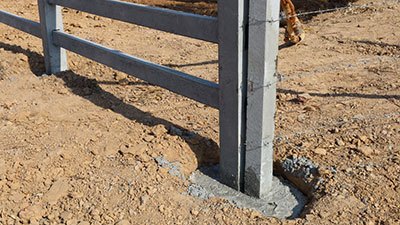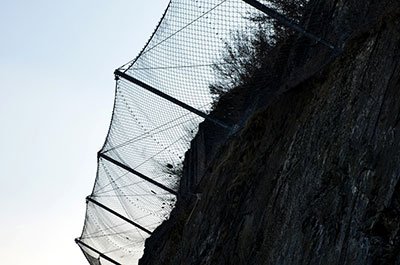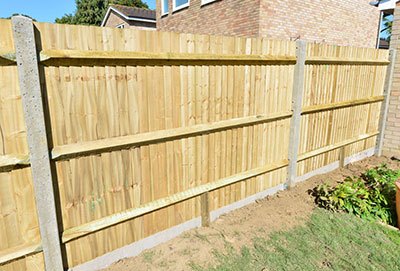Do you need a sturdy fence post to keep your pets or children safe in the yard? Concrete fence posts are an ideal choice. They’re strong, durable, and don’t have any complicated installation requirements.
But if you’ve ever wondered whether concrete posts can be drilled into or not, this article is here to help!
Read on as we answer all our questions about drilling into concrete posts so that you can decide if they’re right for your needs.
Take away key points:
- You can drill concrete fencing posts, but it has its own set of possible issues. So you must take precautionary measures and go slowly to prevent the overall construction
- There are various steps and techniques to follow. Ensure you know them in advance to ensure the best masonry standards
- You can find the whole procedure below for the best hole needs
Table of Contents
- Drilling a concrete fence post: Yes or no?
- Can you drill a concrete fence post?
- What are the possible issues when drilling concrete posts?
- How to drill concrete posts correctly?
- Risks when drilling concrete fencing posts
- Is the SDS drill a good solution for concrete fencing posts?
- Is a hammer drill good for concrete fencing posts?
- Is the replacement of the concrete post a better solution?
- FAQs
- Summary
Drilling a concrete fence post: Yes or no?
If you want to know whether or not you can drill a concrete fence post, and whether there are special techniques, advantages, and disadvantages of the process, refer to the guidelines below.
Can you drill a concrete fence post?

Yes, you can drill such fencing posts, but you need to e careful during the process. Read below.
Concrete fencing posts differ from wood posts or vinyl fence posts in that drilling into them increases the risk of splitting or cracking down the middle, resulting in reduced structural stability.
However, this does not imply that drilling into a concrete fence post is impossible. Rather, it requires specific tools and caution. Also, drilling slowly or stop drilling when you notice the possible breakage is necessary.
Concrete posts are a cost-effective and durable alternative to wooden posts, which are more susceptible to weather and strain. Nonetheless, concrete has a variety of challenges, and drilling may be necessary for repairs or to replace part of your fence.
What are the possible issues when drilling concrete posts?
From a stability perspective, concrete fence posts may contain small or large rocks called aggregate, which contribute to the overall strength of the mix, in addition to mortar. It is rare to find concrete without aggregate unless you are dealing with grout.
Additionally, unlike wood fences, concrete posts usually have three or four vertical sections of rebar running up their length to reinforce them, which are not typically too thick since they function as posts, not concrete slabs.
If you use an inappropriate drill bit or drill for the core drill, you risk damaging the concrete, rendering it unusable as a fence post, or damaging drill bits, making them unusable. So, you must take care when you core drill holes to preserve the drill bits.
How to drill concrete posts correctly?
To drill into a concrete fence post, you’ll need a few things, including an SDS – Slotted Drive System drill, a specific type of drill bits with a tungsten-carbide tip that fits an SDS drill, and patience. It’s critical to be patient and begin drilling slowly and steadily, keeping the smaller drill bit parallel to the fence post.
Start with the smallest SDS drill bit you have, even if it’s too small for the holes you want to make. When you start drilling, go slowly and steadily. If you encounter rebar, move to another spot to begin again.
Regularly remove the drill bit and double-check to blow out excess concrete dust from the hole. Replace the current drill bit with large washers once you’ve reached your desired depth. Repeat the SDS process with progressively larger drill bits until you have the correct-sized hole for your fences.
It’s essential to wear protective gear and appropriate outdoor clothing when drilling into concrete fences. SDS drills create a loud noise that can damage your hearing, and concrete dust can cause long-term eye damage and respiratory issues.
Therefore, it is recommended that you wear protective goggles, gloves, ear protection, and a mask to prevent exposure to concrete dust while drilling. The durability and strength of the effects and tools may not be noticeable right away. It is better to be safe than sorry!
Risks when drilling concrete fencing posts

Assuming that you wear the proper Personal Protective Equipment (PPE), the risks of drills are generally low, except for the possibility of being covered in concrete dust.
However, there is a significant risk of causing irreversible damage to the post-drills. To avoid this, it is crucial to drill directly in the center of the post while being mindful of the presence of rebar.
If you drill all the way through, there is a chance that a chunk of concrete will break out of the back when your drills breakthrough. To reduce this risk, it is necessary to withdraw the drill bit and blow out the concrete dust periodically.
Additionally, cracking is a common issue with drills of concrete posts. Starting with a small bit and gradually increasing the hole’s size can help avoid this problem.
Also, it is helpful to drill a level and in a straight line, using an SDS drill with a built-in bubble level whenever feasible for more support and better job operations.
To prevent the concrete from cracking, it is crucial not to apply pressure to the walls of the hole while drilling. Placing downward or upward pressure on the walls could potentially compromise the concrete and cause it to crack.
Is the SDS drill a good solution for concrete fencing posts?
Yes, SDS drills are a great solution for this job. With their powerful rotary hammer action, they make drilling through tough materials like concrete and masonry a breeze. And if you need to attach anchor bolts or wall plugs, a rotary hammer with an SDS drill Plus bit is the tool you need. You can find different models on the official website.
Is a hammer drill good for concrete fencing posts?
Yes, a hammer drill is another excellent solution for this job. With its ability to handle masonry, a high-quality hammer will help you with drilling holes efficiently in concrete blocks up to 2 inches deep and 1/4 inch wide. So, whether you’re a DIYer or a professional, a fine hammer drill is an essential tool to have on hand for all your concrete drilling needs.
Is the replacement of the concrete post a better solution?

Drilling through a concrete post is a challenging task that can result in cracking or other structural damage. If you find it impossible to drill through without damaging it significantly, it’s probably time to consider repouring a new concrete post.
Although it’s not prohibitively expensive to pour a new concrete fence mold, it can be more labor-intensive and time-consuming than attempting to drill through an existing one.
FAQs
What is the best drill bit for concrete fence posts?
The best solution might be the tungsten carbide tip when dealing with stronger concrete, as these drills are sharper.
How deep to dig holes for concrete fence posts?
The depth should be at least 1/3 of the height of the fence.
What are the disadvantages of concrete fence posts?
The main disadvantage is that these solutions are prone to cracks and chips, causing huge issues with fences.
When a crack occurs on the surface, water will travel to the fence through the small channels, and damage the whole construction. During cold months, the water will freeze and worsen the fences.
Do concrete fence posts have metal inside?
They are full of wire armature inside to provide them with more strength and reliability.
Can you attach a gate to a concrete fence post?
Yes, you can attach a gate to these units.
Can you use mortar to set fence posts?
Yes, you can use mortar to set fence posts.
Summary
It is not impossible to drill into concrete fence posts. It requires a bit of extra effort and some specialized equipment, but the job can certainly be done safely with the right tools.
Above all, caution must be taken to ensure that everything is set up correctly and that it is done in a way that will last for years.
